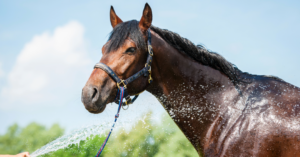
Gastro Pellet: Stomach Well-being Starts in the Mind
Anyone who spends every day around horses knows it well:…
Feed and products in 25kg bags excluded
Bank transfer | Paypal | Credit cards

How do you train an endurance horse?
Let’s try to clarify why it is not so easy to answer this question, which is often asked to those who practice this discipline, and why, if asked to ten different riders, they might give as many different answers.
Certainly, there is no “recipe” that is the same for everyone – there are so many elements that come into play, such as the type of competition being held and the type of horse being trained. These two macro-variables, which have just been mentioned, in turn, cover an infinite number of aspects that cannot be ignored in the preparation of endurance horses.
Every endurance horse (whether Arabian or Anglo-Arabian), although potentially suited to long distances, is unique and must be managed as such. An attentive rider will study a specific work according to a rider’s predisposition, age, physicality, character, strengths and weaknesses and kilometres covered in competition and training, of his four-legged companion from time to time.
Even with regard to the actual race, there are many variables: the distance to be covered (from 20 to 160 km in one day), the number of days of the race (one or two), the type of route (flat or with significant gradients) and the type of terrain.
The work can be broken down into several sessions (3-4 per week) of varying length (2 to 5 hours each) in the open air on country, mixed or mountain tracks at three speeds, combined with galloping sessions on the track (maximum 2 hours) and, where necessary, some work on flat land which is useful to correct, for example, any asymmetry of the horse.
The load phases of the work are gradually and steadily increasing, reaching a peak at a certain point (normally 15 days before the event) and decreasing just as gradually so that the horse can arrive on race day rested but adequately prepared.
The nutrition and integration open up another large and important chapter because, in the preparation phase and during the competition, nothing that the horse eats should be left to chance… just think that some elements must be measured to the gram! Not to mention that veterinary advice and the advice of a nutritionist are essential at all stages of preparation.
With this quick overview, we have seen that the training of an endurance horse is a complex yet fascinating “world”.
We would like to conclude by dispelling a myth or rather an idea that is often held in the collective imagination, especially by those who do not practise endurance sports.
In the preparation of an endurance horse, you never cover the same kilometres during training as you would in a race. For example, a rider preparing for a fast 120 km race does not gallop 100-120 km every time he trains with his horse. Instead, it is the combination of everything that he has done gradually and consistently over the months of preparation that will create the perfect physical condition in the animal to face the competition properly and without risk.

Anyone who spends every day around horses knows it well:…

Intestinal parasites are a common and often underestimated problem in…

As September approaches, the quality and nutritional composition of pastures…

As September approaches, the quality and nutritional composition of pastures…

With the arrival of warmer weather, the competition calendar gets…

The importance Assessing your horse’s physical condition and determining whether…